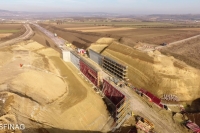A 5 Northern Motorway, Poysbrunn - National Border Section
Client: ASFINAG (Motorway Financing AG) / Provincial Government of Lower Austria
Development Period: since 2004
This project contains the most northern section of the A 5 Northern Motorway between Poysbrunn and the national border towards Brno (CZ). It includes, after overall completion, the new con-
struction of a 9 km long motorway section. Besides extensive earthworks, two partial interchanges and 16 crossing structures have to be built.
In the first step of realisation, the two-lane by-pass Drasenhofen with a length of 5 km is currently under construction. The date of the completion of the whole project up to the border to the Czech Republic depends on the progress of the adjacent Czech motorway project D52.
First of all, BGG Consult prepared the expert's reports in the fields of geology, hydrogeology and geotechnics for the permission and the environmental impact assessment procedure by order of the Provincial Government of Lower Austria, based on direct soil investigations and slug tests. Subsequently, BGG Consult supervised supplementary underground explorations by order of the ASFINAG for the first realisation stage and prepared the expert's report regarding geology, hydrogeology, geotechnics and contaminated sites. During construction, the civil engineering works are supervised from a geotechnical and hydrogeological point of view, inclinometers measured and evaluated and a hydrogeological preservation of evidence conducted.
Wildlife Crossing A5Ü40:
The Wildlife Crossing A5Ü40 with a length of 60 m is situated along an up to 15 m deep road cut. Hence, considerable earth moving works are necessary for the construction with an open cut method without a constructional pit support system. The extend of the earth moving work naturally depends strongly on the possible gradient of the slopes. For a most economic handling, slope gradients as steep as possible were chosen and inclinometer measuring points installed at both sides. Thus, displacements could be identified as early as possible (observational method). While a flattening became necessary on the western side, based on the monitoring results, the originally chosen gradient could be kept on the eastern side.
May 2019
